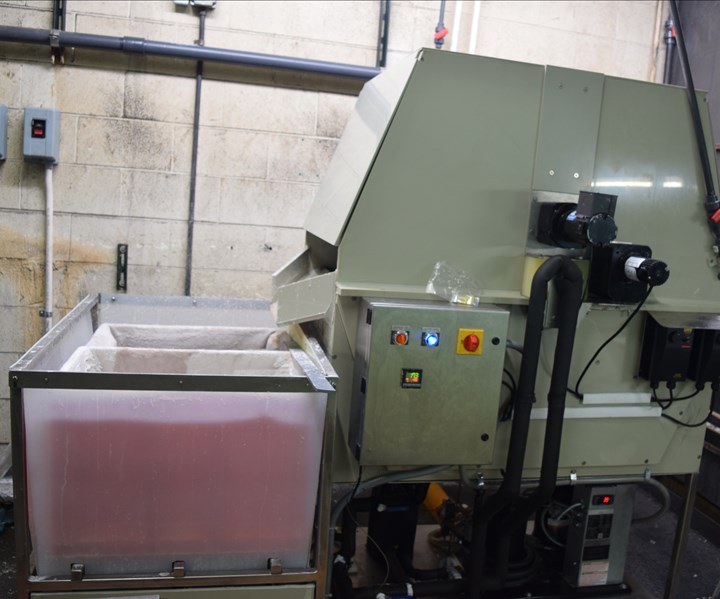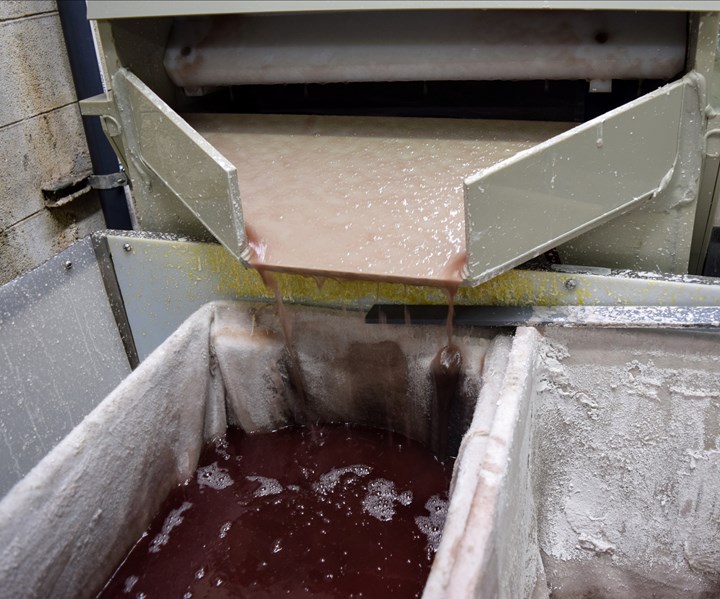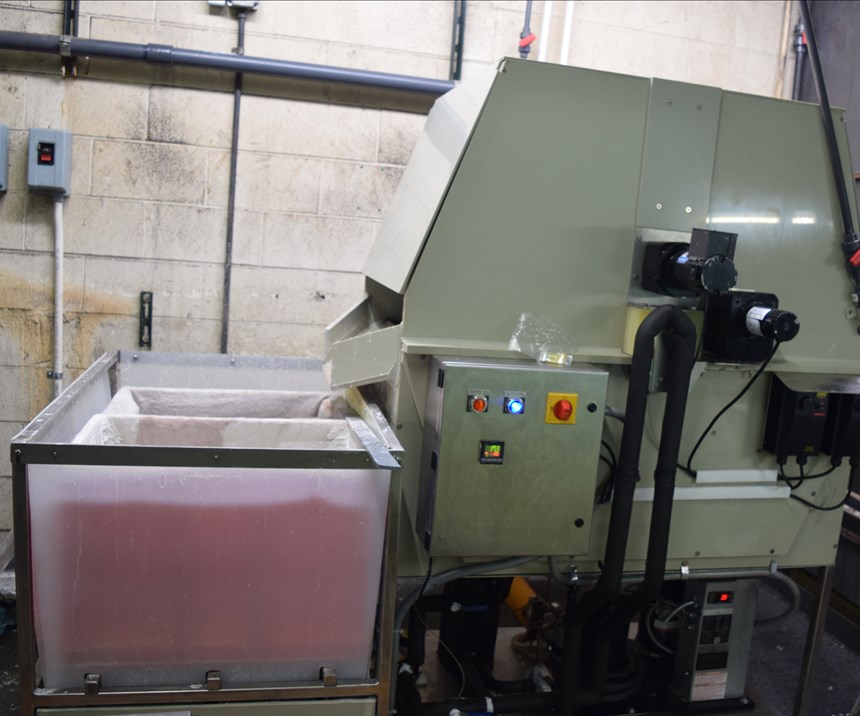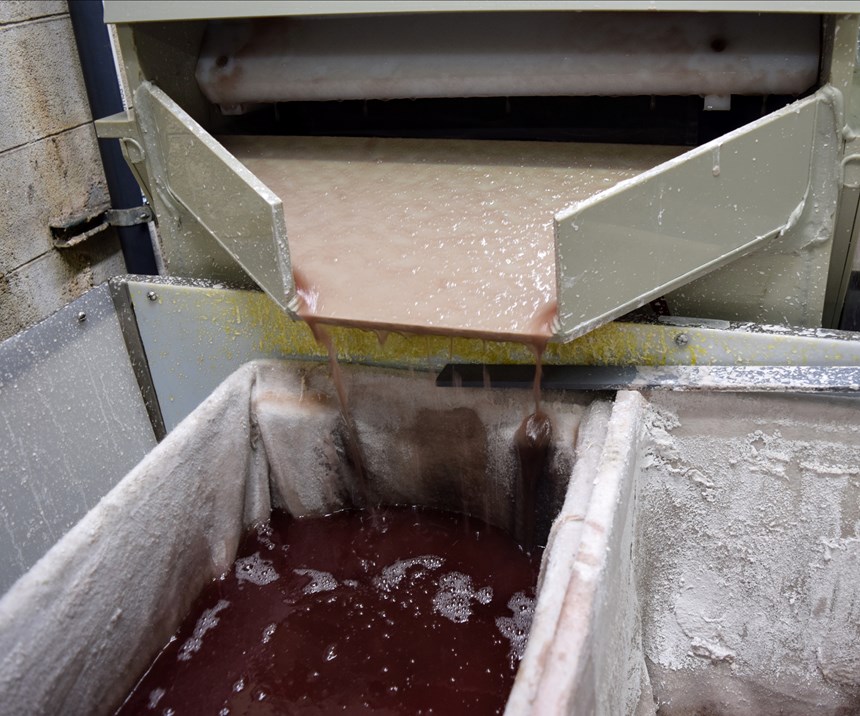Solving the Challenge of Carbonate Buildup in Zinc-Nickel Plating Baths
Plating shop designs a refrigerated drum crystallization method with a flow-through tank that treats a continuous flow of plating bath rather than separate batches.
All alkaline plating baths used in the electroplating of metal parts and assemblies face the same significant challenge: an increasing buildup of carbonates in the plating tank as a result of the electroplating process reduces the efficiency of the process over time and can also directly affect the quality of the resulting plating. This is especially true in zinc-nickel plating, which is one of Gatto’s primary plating operations.
The traditional measures devised by the industry for treating this challenge include a variety of methods for freezing the carbonate-contaminated bath. Significantly lowering the bath temperature crystallizes the carbonate, making it easier to separate from the liquid bath. The methods for doing this have ranged from moving plating tanks or containers carrying the bath outside in winter; using refrigerated trailers to freeze baths; or installing freezer coils in the tanks. All have proved unreliable, messy and extremely labor intensive, requiring a full-time employee dedicated to just removing the separated waste product. This is messy and tiresome work that few people are willing to take on and turnover can be very high. These techniques also often result in the loss of significant volumes of costly plating bath.
Several specialized automated mechanical solutions were also developed to cope with the problem, including batch treatments using belts, bag filters and centrifuges. All succeeded in removing carbonate from bath solutions in varying degrees, but all treated small batches of plating bath at a time, were time-consuming, and still required labor-intensive removal of the crystallized carbonate following separation. A high-volume plating operation might require several of these systems to deal with the volume of carbonate. These inefficient systems are costly, and require valuable space on the shop floor and maintenance time.
The challenge facing platers was to develop a better method for removing carbonate buildup quickly and effectively, to make plating operations more efficient.
For Gatto Industrial Platers, the carbonate challenge was even greater because the larger the plating bath is in volume, the larger the problem; and Gatto’s are among the largest tanks in the industry. Gatto addressed this challenge for years and, like others in the industry, tried multiple solutions, all of which proved less than satisfactory. Finally, after extensive experimentation, its technical manager developed a refrigerated drum crystallization method with a flow-through tank design that treats a continuous flow of plating bath rather than separate batches. It can treat a flow rate of 60-120 gallons of bath per hour and ejects a portion of carbonate slush every 1.5 minutes for further treatment that will further separate the carbonate crystals from the slurry liquid and recover almost 100% of the plating bath for reuse.
In operation, the carbonate ejection system is connected to the plating tank by hoses and a pump. The plating bath is pumped into the system, treated and returned to the plating tank. Carbonate slush is transferred to a separate system for further separation, which recovers additional bath to be returned to the plating tank.
The Gatto system increases the removal rate of carbonate over previous systems by a factor of 20, reduces the carbonate handling time by 80%, and eliminates the need for (and cost of) manual removal. It also requires significantly less floor space and only minimal maintenance. As a result, it has enabled Gatto to expand its plating capacity without incurring the additional cost of more expensive, less efficient carbonate removal equipment.

Designing, Constructing the Carbonate Ejection System
Designing the physical system began with research into which materials would work best to construct the tank and how the refrigerated drum at the center of the system would function. This involved interviewing multiple equipment vendors and material suppliers, many of whom had not tackled a comparable challenge.
It was determined that the treatment tank and elements of the ejecting mechanism would need to be of plastic, precisely machined and welded into a precise shape to facilitate the smooth movement of the crystallizing drum and ejecting mechanism throughout the process and to not allow the crystals to accumulate inside the tank.
The central element of the system, the refrigerated drum, was constructed of stainless steel, and its surface treated to promote the crystallization of the carbonate, with some portions polished to a mirror finish. The drum of the original system, designed for use with Gatto’s high plating bath volume, measured 36 inches in diameter by 30 inches wide, was hollow and turned on hollow axles to reduce weight. The refrigeration system condenser was also purchased from a supplier, while Gatto constructed the system’s heat exchanger in-house.
The critical parts that were produced by suppliers were then assembled in-house by the Gatto maintenance team, which also fabricated the base on which the system rested.

Carbonate Ejection System Operation
The two operating principles of the carbonate ejection system are to keep the flow of treated bath moving and to induce crystallization of undesired salts on the refrigerated drum (primarily sodium carbonate, but also ferrous chloride, ferrous sulfate, sodium sulfate, aluminum sulfate, aluminum hydroxide and more — all of which are compounds with low solubility at lowered temperatures). This is accomplished by intermittently lowering the temperature of the incoming plating bath to below the saturation point of these compounds. The crystallized salts slurry that collects in the tank is then ejected from the tank by a wiper every 1.5 minutes.
The unit performs this treatment using an innovative continuous flow-through design, processing approximately 1 to 2 gallons per minute of the incoming bath through the treatment compartment. This is in contrast to other batch treatment methods that use small 16- to 50-gallon volumes with long cycle times that could not process 24,000 gallons of bath.
As the crystallization treatment takes place, the ejected slurry containing the crystallized contaminants is transferred (after initial drainage) to the secondary unit where the crystallized material is further separated from the liquid by quick centrifugation or spin drying, allowing the now cleaned solution to be reused in the plating tank, therby saving significant material cost. The other function of the secondary unit is that, in the next step, it sends the separated carbonate directly to the waste treatment stream. This eliminates carbonate accumulation and the need to send it for disposal as hazardous waste.
The original carbonate ejection system was assembled to meet the plating bath needs of large operations. A second-generation carbonate ejection system was later developed and built with smaller tanks. This is an improved version of the original system, with a footprint and capacity approximately 30% smaller, suitable for operations with plating tanks of less than 10,000 gallons, but with similar characteristics. The cooling capacity, for example, is only slightly less than that of the original design.
The system’s operating principles are the same, but improvements to the overall design have simplified and improved the system’s efficiency, resulting in a lower cost for both purchase and operation. As opposed to the 36 by 30-inch drum of the 3036, the smaller drum is 32 inches in diameter by 20 inches wide. The unit runs at a slightly slower flow volume, is not programmable, and is controlled by an operator who makes adjustments, when needed, by way of manual knob controls.
Related Content
NASF/AESF Foundation Research Project #120: Electrochemical Destruction of Perfluorooctanesulfonate in Electroplating Wastewaters - April 2022-March 2023
This NASF-AESF Foundation research project report covers project work from April 2022 to March 2023 at the University of Illinois at Chicago. The overall objective of this work is to utilize a cost-effective reactive electrochemical membrane (REM) for the removal of PFAS from synthetic electroplating wastewater. Initial results for the oxidation of PFOA with three different catalysts are discussed.
Read MoreNASF/AESF Foundation Research Project #120: Electrochemical Destruction of Perfluorooctanesulfonate in Electroplating Wastewaters – January – December 2023
This NASF-AESF Foundation research project report covers quarterly reporting for the year 2023 at the University of Illinois at Chicago. The objective of this work is to utilize a cost-effective reactive electrochemical membrane (REM) for the removal of PFAS from synthetic electroplating wastewater. Discussed here are the oxidation of PFOA with three different catalysts, development of a method for detecting PFAS, as well as work on 6:2-fluorotelomersulfonic acid (6:2 FTS) and electrodeposited bismuth/tin oxide catalysts.
Read MoreNASF/AESF Foundation Research Project #122: Electrochemical Approaches to Treatment of PFAS in Plating Wastewater - 12th Quarterly Report
This NASF-AESF Foundation research project report covers the 12th quarter of project work (October – December 2023) at the University of Georgia. In our previous report, we described our work on performance and effect of surface fluorinated Ti4O7 anodes on PFAS degradation in reactive electrochemical membrane (REM) mode. This quarter, our experiments involved utilizing porous Ti4O7 plates serving both as anodes and membranes. Tests compared pristine and F-18.6 Ti4O7 anodes at current densities of 10 mA/cm2 and 40 mA/cm2. This 12th quarterly report discusses the mechanisms of the effects on EO performance by anode surface fluorination.
Read MoreNovel Wastewater Treatment Targets Micropollutants
Swiss wastewater treatment technology provider Oxyle specializes in advanced wastewater treatment for removal of highly persistent micropollutants such as PFAS.
Read MoreRead Next
Delivering Increased Benefits to Greenhouse Films
Baystar's Borstar technology is helping customers deliver better, more reliable production methods to greenhouse agriculture.
Read MoreEpisode 45: An Interview with Chandler Mancuso, MacDermid Envio Solutions
Chandler Mancuso, technical director with MacDermid Envio discusses updating your wastewater treatment system and implementing materials recycling solutions to increase efficiencies, control costs and reduce environmental impact.
Read MoreEducation Bringing Cleaning to Machining
Debuting new speakers and cleaning technology content during this half-day workshop co-located with IMTS 2024.
Read More
















.jpg;maxWidth=300;quality=90)







